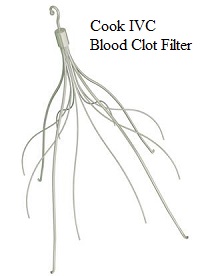 IVC filter lawsuits are being filed because the preponderance of evidence fails to show that IVC filters are worth their risks. We are consequently filing IVC filter lawsuits across the country. Matthews & Associates Law Firm will try the first Cook IVC lawsuit in state court in the country in a trial beginning May 15, 2018 in Houston, Texas.
IVC filter lawsuits are being filed because the preponderance of evidence fails to show that IVC filters are worth their risks. We are consequently filing IVC filter lawsuits across the country. Matthews & Associates Law Firm will try the first Cook IVC lawsuit in state court in the country in a trial beginning May 15, 2018 in Houston, Texas.IVC filter makers such as Cook Medical and C.R. Bard sell fear, first, in order to promote their products. They always point to the dangers of pulmonary embolism, and claim IVC filters are the only answer to PE when someone is contraindicated for blood-thinning medication.
Pulmonary embolism is undoubtedly a problem, for a reported 422 of 100,000 people in the United States. Left untreated, PE will occur in as many as 40% of all people who develop proximal deep vein thrombosis (DVT).
But identifying a problem doesn’t mean you’ve solved it, or even offered the best solution. Significant controversy surrounds the “appropriate indications” for IVC filter placement. Scientific literature regarding the safety and efficacy of IVC filters is woefully lacking.
Related: IVC Filters risk serious complications
All published guidelines agree IVC filters are indicated in patients who have an acute VTE and cannot receive anticoagulation medications. Or they are indicated for those whom adequate anticoagulation has clearly failed despite evidence of appropriate use and effect. Nevertheless, some indications are much more controversial.
Dr. Ido Weinberg and others pointed out in a 2012 IVC filter paper, Cardiovascular Interventions by the American College of Cardiology Foundation, that IVC filters are inserted perioperatively in patients undergoing surgical pulmonary embolectomy. The intent is to reduce the effect of post-surgical PE in this unstable population. In a retrospective analysis of mortality in 520 such patients who were unstable secondary to PE, and who underwent embolectomy – all of whom received an IVC filter – mortality was lower than in 430 patients who received no filter (25% to 58%). The authors wrote that other safety data are conflicting, yet the Society for Interventional Radiology guidelines and ACR appropriateness criteria inexplicably offer that data as a relative indication for placing an IVC filter.
IVC filters are also advocated for high-risk populations without VTE as a prophylactic measure, such as in trauma patients. But several points of controversy apply. First, placing a filter can add complications that include increased morbidity. Second, patients are at risk for long-term complications if filters are not removed. Third, studies have shown IVC filters are a poor choice for trauma patients.
IVC filters have also been advocated for people undergoing elective open gastric bypass surgery. Those who received the filters have not been shown to fare any better than those who did not. In fact, studies have shown IVC filter risks outweigh benefits for bariatric patients.
IVC filters are sometimes used in high-risk patients in conjunction with anticoagulation therapy. In a comparison of 251 patients who received both an IVC filter and anticoagulation meds, and 1,377 who received only anticoagulation, there was no difference in PE incidence at 90 days and 5 years, though a trend toward more DVTs in the IVC filter group.
Cochrane Review: compression and anticoagulation effective and safe
Dr. Weinberg and the authors write that, “It is noteworthy that a Cochrane review of combined intermittent compression and anticoagulation for VTE prevention in high-risk patients showed the combination to be effective and safe.” Which would seem to seriously challenge the notion of IVC filter makers that their filters are the only option in town for high-risk patients.
Do IVC Filters prevent PE?
A population-based study analyzed hospital records from 1991-1995. It found that the rate of rehospitalization for PE did not decrease with the use of IVC filters. Rehospitalizations for DVT, however, did increase with the increased filter use. Further, Cochrane database investigators could not draw firm conclusion as to whether the filters decreased PE at all.
IVC filter lawsuits filed against Cook and Bard argue that these companies did no relevant long-term studies which randomized patients to find the true effectiveness of their filters. They diligently avoided performing those tests because they knew their IVC filters had no true effectiveness, and that IVC filter benefits are often not worth their risks.
IVC Filter Risks
IVC filters can become embedded in the vena cava. They can also break apart, and their various pieces can travel to the heart, lungs, nearly anywhere the blood can take them in the human body. They have not been proven efficacious. They are decidedly dangerous, and that is why you see so many IVC filter lawsuits filed in state courts and in federal multi district litigation courts across the country.
Related
- IVC Filter Lawsuit | Lawyer
- Bard IVC Filter Lawsuit
- Cook IVC Filter Attorney

by Matthews & Associates




